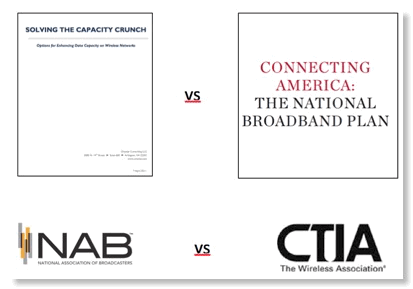Battle of the Trade Associations:
NAB vs. CTIA Spectrum Fight

Readers of this blog are probably aware that your blogger is not greatly loved at either NAB or CTIA. While NAB staff at least return phone calls and e-mail messages after a while, CTIA staff do not - apparently their response to criticism herein.
This week NAB released the report shown above, SOLVING THE CAPACITY CRUNCH: Options for Enhancing Data Capacity on Wireless Networks.
The NAB press release, entitled “Study Discredits Claim of Spectrum Crisis for Mobile Broadband--FCC filing offers spectral efficient solutions to address capacity crunch”, starts,
“The National Association of Broadcasters yesterday filed with the FCC a study by former FCC official Uzoma Onyeije questioning the existence of a spectrum crisis. The paper, entitled ‘Solving the Capacity Crunch: Options for Enhancing Data Capacity on Wireless Networks’, suggests alternative solutions to auctioning broadcasting spectrum to help alleviate mobile broadband congestion.”
(The report is certainly available on the NAB website, as shown in the link above,but finding it at FCC is trickier. It is at p. 37-72 of this joint NAB/MSTV filing in Docket 10-135.)
I have worked with the author both at FCC and more recently as a consultant when he was at M2Z Networks and I have the highest regard for him. But the NAB characterization of him as a “former FCC official” is typical of NAB consistently hiring consultants who are “predictable” and then spinning their reports while fuzzifying their qualifications for the issue at hand. Mr. Onyeije has degrees in accounting and law and does not claim qualifications in telecom technology other than his tenure at FCC as Broadband Legal Advisor to the Chief of the FCC's Wireless Telecommunications Bureau. That said, however, I have to agree with much of what he said with respect to technical options for the 500 or 800 MHz “needed” for broadband.

Onyeije ’s report is also reminiscent of an “associate item” OET’s predecessor OST prepared for the Commission in 1983 on this subject of meeting spectrum growth. Even if you have been in the spectrum area within the FCC for 20 years, you may not have heard the term “associate item”. This was a proper procedure, defined in the FCC’s internal Agenda Handbook, for FCC bureaus and offices to let the Commission know they disagreed with an agenda item put for by another element. (It appears that this internal FCC procedure disappeared in the 1980s and this may well be the last such associate item ever sent to the Commission by the staff as staff disagreements were then frowned upon by the “8th Floor”. Was the elimination of associate items actually an improvement?)
OST disagreed that the only way to meet projected demands was through more spectrum and pointed out to the Commission the spectrum demands can often be a self-fulfilling prophecy if they are denominated in MHz and that technology is key to converting actual information transfer needs into MHz. Of course, we now know that will cellular architecture capital investment in infrastructure is another key factor - but that was not so clear in 1983.
The 1983 OST associate item stated as a “basic concern”:
“We believe that the technology projection in the report are generally too pessimistic on equipment availability and its impact on spectrum needs and neglect the close relationship between equipment development efforts and the regulatory climate...We feel that the Commission can create a regulatory climate where ... new technologies would become available for (mobile) users. Such regulatory climate would also have the side effect of increasing the competitive position of the U.S. communications industry in the world market.”
These words were written 28 years ago, but are quite meaningful today also. While the Commission and NTIA are busy focusing on the Broadband Plan’s 500 MHz goal, they don’t seem to be paying much attention to the Docket 09-157 wireless innovation issues in the 610 days since that NOI was issued.
Society and the economy do not need x MHz to meet their needs, they need communications capacity. Wireless communication capacity is in turn achieve through a combination of
- spectrum
- technology and
- investment in infrastructure
UPDATE
CTIA response to Onyeije report



![Validate my RSS feed [Valid RSS]](valid-rss-rogers.png)

